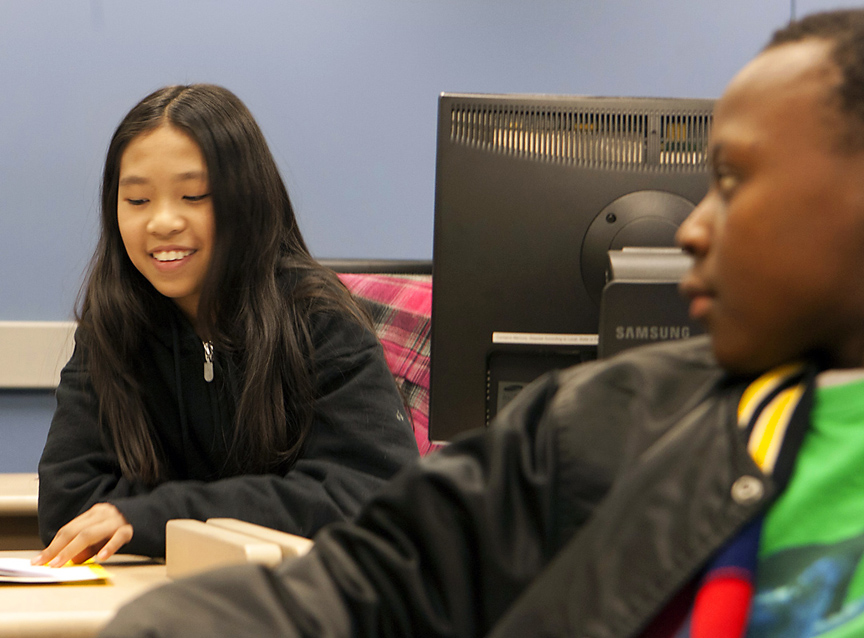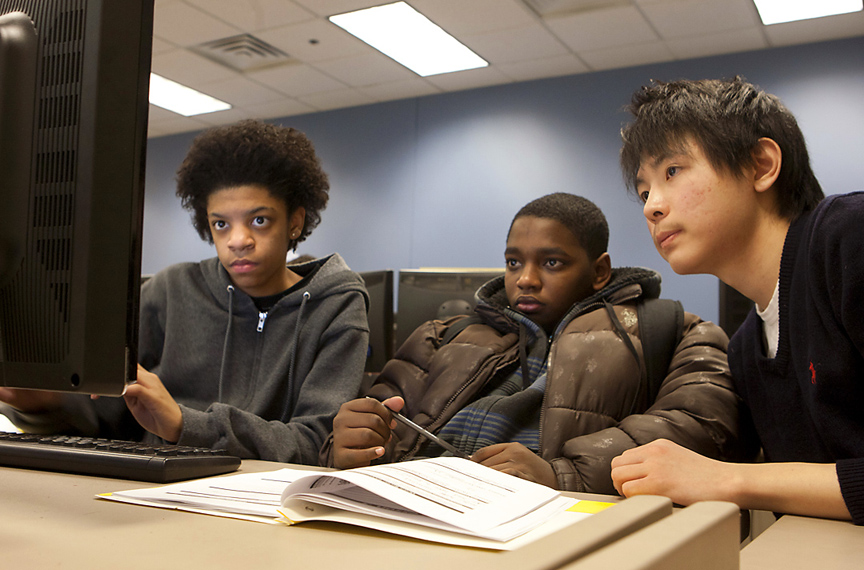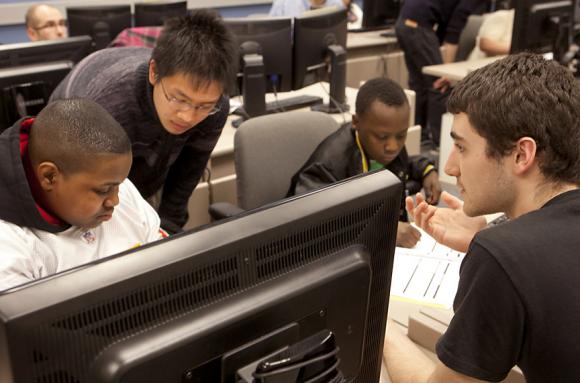Madavin Vong’s eyes lit up as the blue rocket spewed a puff of cartoonish smoke and lifted off on her computer screen.
“Yeah!” she exclaimed. “We did it!”
The 11-year-old Vong was excited because she had mastered the computer and math skills necessary to make the rocket soar. She was doing the programming on the Brown University campus through a class taught by Brown undergraduate students for Providence-area school children.
Vong loves video games. Her favorites are ones styled on adventure, fighting, and — perhaps in an odd twist for someone so young — on time management. Now, through a program run by a nonprofit educational outfit called Bootstrap, she was getting a chance to create her own video game.
“Basically, I want to see how they make them,” said Vong, who is in sixth grade at Gilbert Stuart Middle School. “To make [characters] move is a really cool thing.”

For about 10 weeks, up to a dozen middle-school students from Providence-area schools ride a bus after school to Brown to fulfill their dreams of creating their own superheroes, villains, monsters, stellar athletes, or super-organized geniuses. The video game, while real, is the hook to expose the children to computer science and to deepen their mathematics skills, according to Shriram Krishnamurthi, associate professor of computer science at Brown and a pivotal backer of the Bootstrap class. Enticing them with a straight-on programming class would be “a hindrance, rather than a help,” he says.
“The pitch is, Wouldn’t you like to write your own video game?” said Krishnamurthi, who made Bootstrap’s video-game software accessible via the Web and has helped with fundraising.
For the students who filed into a computer room at the Center for Information Technology for the first class last month, the answer would appear to be yes. These kids, with backgrounds from Cambodia, Haiti and El Salvador, were eager to get started. Their teacher, Brown sophomore Kurt Spindler, urged caution. “We’re here to make video games,” he assured them, “but the thing about video games, is they’re complicated.”
The students soon learn that’s the case. They get drilled on x and y coordinates and, in a later class, are introduced to programming code needed to create shapes and animation. They seem vaguely aware of, yet little deterred, by the algebra and computer science as they furiously complete exercises in their workbooks.

That’s the goal behind Bootstrap, said Emmanuel Schanzer, a Providence native and the program’s creator. While teaching math and computer science classes in Boston-area schools, Schanzer found that his students reacted cooly to algebra and computer programming. So Schanzer, who studied computer science in college and worked for a while at Microsoft, devised a curriculum that effectively masked the fact that his students were tackling heavy math and computer programming. That curriculum led to Bootstrap, now in its fifth year and running after-school classes for urban schoolchildren in Austin, Texas, the Bay Area in California, Boston, New York, and Providence. “I had my life plan,” Schanzer related. “I’d make my millions and then go on to teaching. But I realized I wanted to teach full time.”
Brown’s involvement with Bootstrap began in spring 2010, with undergraduates teaching the after-school class at the middle schools. The class now takes place at the university, with transportation provided by the Providence After School Alliance. Each semester, about a half-dozen Brown students volunteer to teach, making the instruction for the middle-schoolers more of a hands-on tutorial than an impersonal lecture. “Sometimes, the kids are like, ‘Oh, why are we doing this? I want to play video games,’” said Spindler, wearing a black Bootstrap T-shirt with “I program my own video games” on the front. “Other times, they say, ‘Oh my, computer science is so cool. I want to go to college.’ That is exciting and visceral.”
It’s too early to know whether Vong will attend college, but she’s well on her way to creating her own video game — and enjoying the ride.
“We have a long way to go, [but] I’m ready for the adventure,” she says during a short break. “Ready, ready.”

